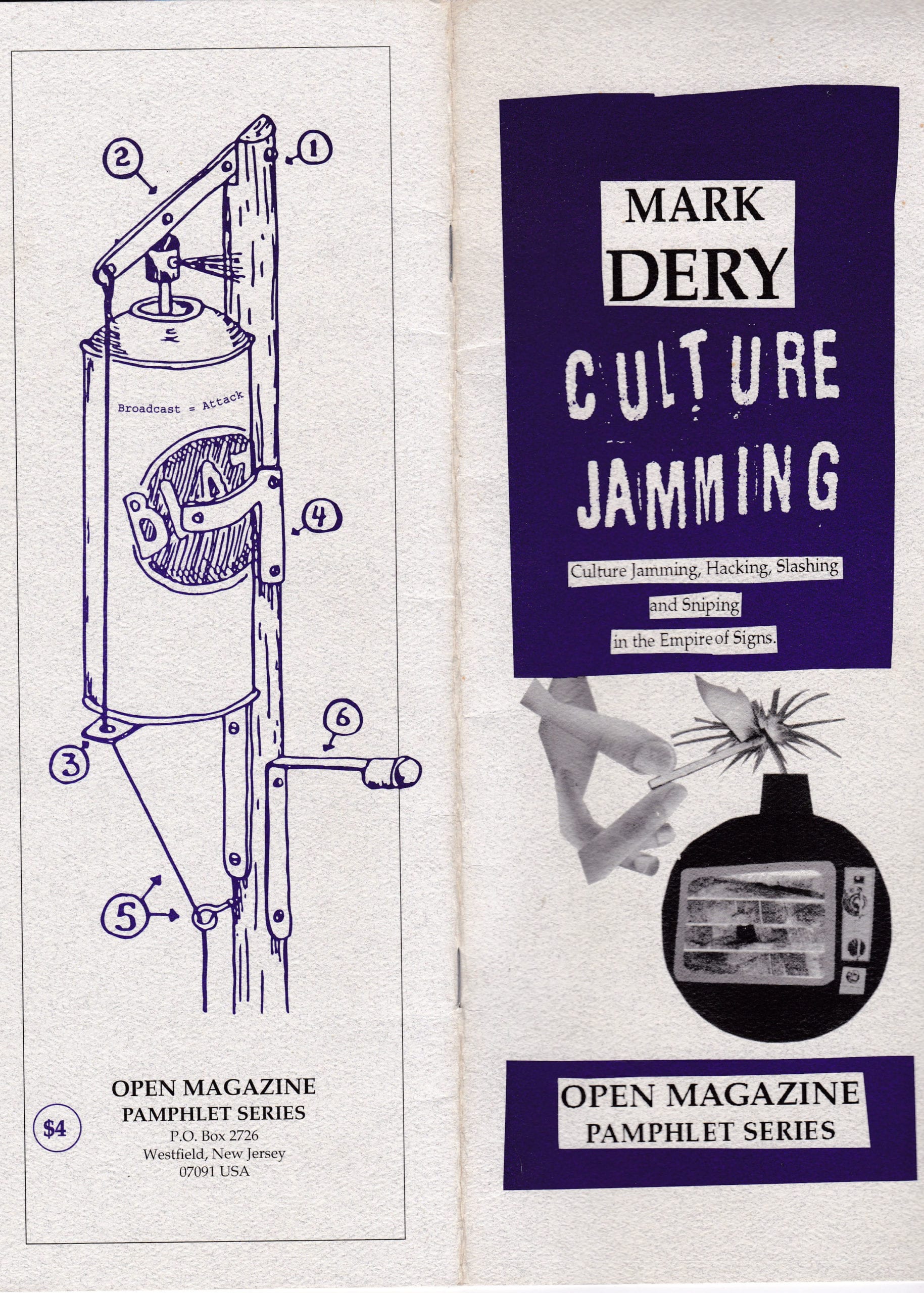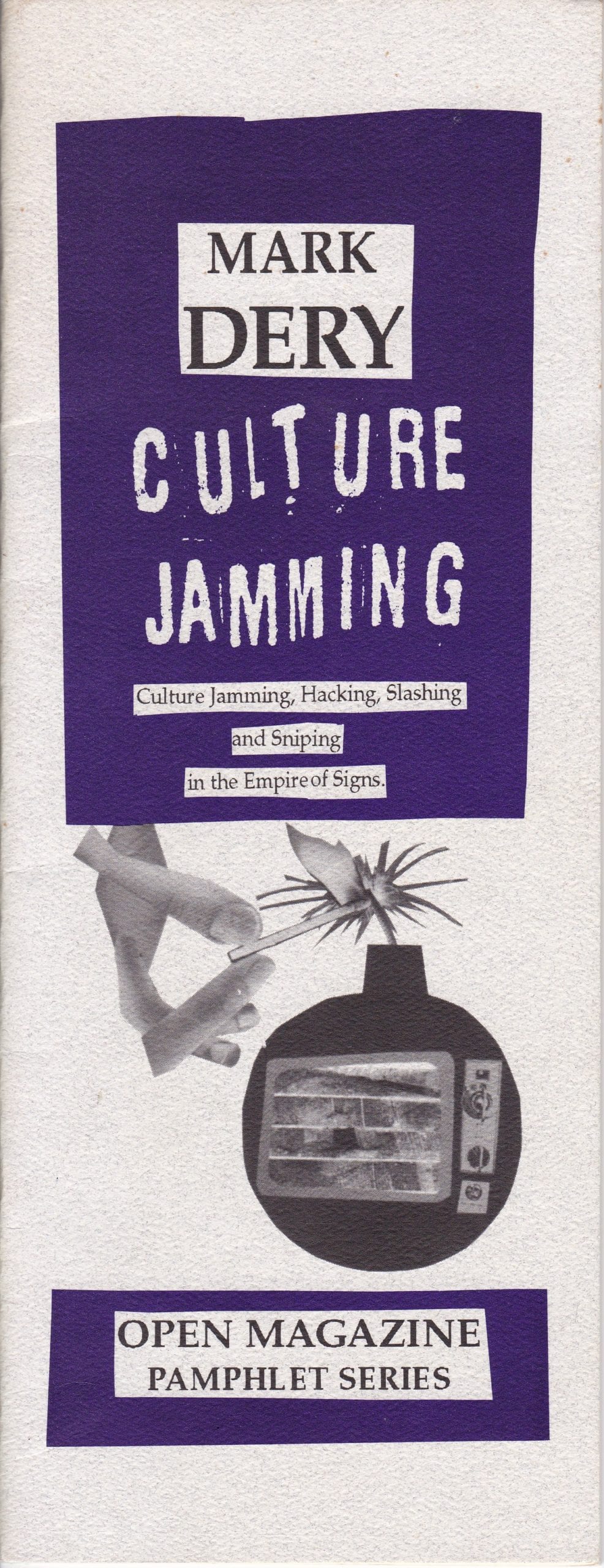A Brief Introduction to the 2010 Reprint:
The term “cultural jamming” and the concept behind it first appeared on JamCon ’84, a 1984 cassette-only release by the audio-collage band Negativland.
The group, whose sociopolitical satire and media criticism often have a sharp, Situationist edge, applied the idea of “jamming” to billboard banditry. (Jamming was the joke-y, trollish practice, then prevalent in the C.B. radio community, of disrupting other users’ conversations with obscene or nonsensical interjections; billboard banditry is the neo-Situationist practice of illegally altering billboards to perversely funny, usually political effect in order to critique consumerism, capitalism, representations of race and gender in advertising, or American foreign policy. )
Inspired by Negativland’s work in general, and JamCon ’84 in specific, I used my readings in postmodern theory, Baudrillard, McLuhan, and the politicized cultural histories of Stuart Ewen to historicize and theorize in depth Negativland’s notion of “cultural jamming,” which my Inner Grammarian insisted on retooling as culture jamming.
In my December 1990 New York Times article on the subject—the first appearance of the phrase and the concept in the mainstream media—I used Negativland, the media hoaxer Joey Skaggs, the graffiti artist Robbie Conal, the parody billboard painter Jerry Johnson, and Reverend Ivan Stang of the tongue-in-cheek Church of the Subgenius cult as poster children for culture jamming—media age provocateurs who expose “the ways in which corporate and political interests use the media as a tool of behavior modification.”
In my 1993 Open Magazine pamphlet, Culture Jamming: Hacking, Slashing, and Sniping in the Empire of the Signs, a revised version of which appears below, I theorized the concept in depth, teasing out its historical precedents and excavating its philosophical foundations, among them Bakhtin’s reading of medieval carnival as symbolic subversion, the Situationist theory of the Spectacle and concomitant practice of détournement, and the Baudrillardian theory of postmodern society as a hyperreality. The conceptual thread running through the secret history and philosophical operating code of culture jamming was the idea of guerrilla semiotics, a term I coined* and which I unpack at length in my essay, below. *(Debt to Umberto Eco’s concept of “semiological guerrilla warfare” duly acknowledged here.)
After I published my New York Times article, I wrote a series of articles for the Canadian anti-consumerism magazine Adbusters, beginning with “Subvertising: The Billboard Bandit as Cultural Jammer” (Adbusters, Fall/Winter 1991, Volume 2, Number 1), in which I introduced editor/publisher Kalle Lasn to the term “culture jamming” and the theories it embodied.
Lasn took the concept and ran with it, branding his magazine as the house organ of the Culture Jamming Movement®, peddling anti-consumerist swag through the magazine’s website, and publishing a jammer’s manifesto of sorts, Culture Jam: The Uncooling of America, a strategy that has earned him the ire of jammers like Carrie McLaren, who in her essay “CULTURE JAMMING ™ brought to you by Adbusters ” charges Lasn with reducing the phenomenon to
a few pointless vagaries (“challenge your economics professors to justify their scientific credentials in class”) and things to buy–air-time on local TV to air Adbusters’ anti-commercials, Buy Nothing Day promo goods (irony, anyone?), and the Culture Jammer’s toolbox, where, for $35, you get a poster, stickers, The Culture Jammer’s Video, a Buy Nothing Day t-shirt and extra copies of Adbusters. Then inside the back page, in case you missed those two pages, there’s a full page of Culture Jamming materials. A set of six posters and postcards ($15), the Culture Jammer’s Calendar ($13), The Culture Jammer’s Video and Back Issues. Order before September 15 and get a second calendar free! …Beat ’em at their own game, I guess is the thinking. But what comes out is no real alternative to our culture of consumption. Just a different brand.
What she said. I share McClaren’s pique at Adbuster’s complicity in the commodification of anti-consumerism (not to mention Lasn’s benign neglect, in too many interviews, of the role my work played in bringing the concept to his attention).
Adbusters‘ exhortations to critical thinking and media literacy are crucial, especially when they fall on teenage ears. My ambivalence about the magazine springs from its shrink-wrapping of anti-consumerism: culture jamming calendars replete with subscription cards and merchandise order forms, and so forth. Also, my nose wrinkles at the Dworkinesque censoriousness that wafts from the magazine’s neo-puritan insinuation that alcohol use leads inevitably to alcohol abuse, that coffee consumption is a profound social evil. In such moments, it exudes the deep-rooted distrust of the masses’ ability to police their own desires that makes strange bedfellows of moral crusaders on the left and the right.
Seventeen years after my manifesto hit indie bookstores, the look and feel of culture jamming, at least, have been appropriated by the mainstream, tirelessly promoted by Adbusters (oh, the irony!) and hijacked by guerrilla advertisers to ambush unsuspecting consumers. Perhaps it’s high time we asked whether it, like the medieval Feast of Fools to which it is distantly related, was always just a socially sanctioned release valve–a tactical outlet for class resentments and pent-up dissent over social injustices and economic inequities that might have found more profoundly political expression if they hadn’t been harmlessly exorcized via rituals of resistance.
But that, wise crowd, is a question I leave to you.
– Mark Dery, October 8, 2010
A Note About the Creative Commons:
Culture Jamming: Hacking, Slashing, and Sniping in the Empire of Signs was published in broadside form by the Open Magazine Pamphlet Series in 1993. That pamphlet, with its eye-grabbing cover by the collage artist Stephen Kroninger, is long out of print. Although you can still find the odd copy of the original pamphlet for sale on the Web, they’re rare as hen’s teeth and are priced accordingly.
Of course, following the cultural logic of the Digital Age, which is the same as that of Jurassic Park–namely, that anything that can be stored as information (sequenced, scanned, or otherwise encoded) can be raised from the dead–Culture Jamming lives on, in the purgatory of the virtual, all over the Web.)
In solidarity with the ideas-as-intellectual-freeware movement, which champions an “open source” approach to ideas at a time when corporations are privatizing more and more intellectual property, I’m making Culture Jamming available to anyone who wants to archive it on his or her site, photocopy it for classroom use, or otherwise circulate it for noncommercial use. In return, I ask only that you credit me as the author and, ironically, copyright holder, as in: “© Mark Dery; all rights reserved.” I’m open-sourcing the ideas in this essay, not licensing users to profit from the republication and resale of my work. That’s stealware, not shareware.
Praise for Culture Jamming:
“Widely republished in print and on the Web, Culture Jamming helped spark the guerrilla media activism movement associated with Adbusters magazine (to whom Dery, as a columnist, introduced the concept). It remains the definitive theorization of this subcultural phenomenon.”– Wikipedia
“An excellent springboard for anyone wishing to explore this fascinating form of art and revolt.” – Boing Boing magazine


